Ijraset Journal For Research in Applied Science and Engineering Technology
- Home / Ijraset
- On This Page
- Introduction
- Conclusion
- References
- Copyright
Formulation and Evaluation of Herbal Face Scrub
Authors: Anjali Shinde, Bhagyashri Gayke, Madhuri Khandgaonkar
DOI Link: https://doi.org/10.22214/ijraset.2023.54833
Certificate: View Certificate
Abstract
Introduction
I. INTRODUCTION
The word cosmetic?s was derived from the Greek word “kosm tikos” meaning having the power, arrange, skill in decorating1. The origin of cosmetics forms a continuous narrative throughout the history of man as they developed. The man in prehistoric times 3000BC used colours for decoration to attract the animals that he wished to hunt and also the man survived attack from the enemy by colouring his skin and adorned his body for protection to provoke fear in an enemy (whether man or animal)2. The origin of cosmetics were associated with hunting, fighting, religion and superstition and later associated with medicine3. Herbal Cosmetics, here in after referred as Products, are formulated, using various permissible cosmetic ingredients to form the base in which one or more herbal ingredients are used to provide defined cosmetic benefits only, shall be called as “Herbal Cosmetics”4. Beginning 1990's cosmetic manufacturer adapted a term 'cosmeceuticals' to describe the OTC skin care products that claims therapeutic benefit by addition of plant based active ingredient such as alpha-hydroxy acid, retinoic acid, ascorbic acid and coenzyme Q105.
These active ingredients serves many purposes viz. increase in skin elasticity, delay in skin aging by reducing the wrinkles, protection against UV radiation by antioxidant property and to check degradation of collagen respectively6. The skin and hair beauty of individuals depends on the health, habits, routine job, climatic conditions and maintenance7. The skin due to excessive exposure to heat will dehydrate during summer and causes wrinkle, freckles, blemishes, pigmentation and sunburns. The extreme winter cause damages to the skin in the form of cracks, cuts, maceration and infections8. The skin diseases are common among all age groups and can be due to exposure towards microbes, chemical agents, biological toxin present in the environment, and also to some extend due to malnutrition9. The science of ayurveda had utilized many herbs and floras to make cosmetics for beautification and protection from external affects10. The natural content in the botanicals does not cause any side effects on the human body; instead enrich the body with nutrients and other useful minerals11. The cosmetics, according to the Drugs and Cosmetics Act is defined as articles intended to be rubbed, poured, sprinkled or sprayed on, introduced into or otherwise applied to the human body or any part thereof for cleansing, beautifying, promoting attractiveness or altering the appearance12. The cosmetic does not come under the preview of drug license. The herbal cosmetics are the preparations containing phytochemical from a variety of botanical sources, which influences the functions of skin and provide nutrients necessary for the healthy skin or hair 13. The natural herbs and their products when used for their aromatic value in cosmetic preparation are termed as herbal cosmetics14. There is common belief that chemical based cosmetics are harmful to the skin and an increased awareness among consumers for herbal products triggered the demand for natural products and natural extracts in cosmetics preparations15. The increased demand for the natural product has created new avenues in cosmeceutical market. The Drug and Cosmetics Act specify that herbs and essential oils used in cosmetics must not claim to penetrate beyond the surface layers of the skin nor should have any therapeutic effect16. The legal requirement and the regulatory procedures for herbal cosmetics are same as that for other chemical ingredients used in cosmetic formulations17.
The requirements for the basic skin care: Cleansing agent: which remove the dust, dead cells and dirt that chokes the pores on the skin. Some of the common cleansers include vegetable oils like coconut, sesame and palm oil18. Toners: The toners help to tighten the skin and keep it from being exposed to many of the toxins that are floating in the air or other environmental pollutants. Some of the herbs used as toners are witch hazel, geranium, sage, lemon, ivy burdock and essential oils19. Moisturizing: The moisturizing helps the skin to become soft and supple. Moisturizing shows a healthy glow and are less prone to aging20. Some of the herbal moisturizers include vegetable glycerin, sorbitol, rose water, jojoba oil, aloe vera and iris21.
A. What is Exfoliant?
A facial scrub uses small particles, beads or chemicals to get rid of the old skin cells and make way for new once in a process known as exfoliation. The agents are used for exfoliation are known as exfoliants. Exfoliating agents are those used to remove dead cells present on the skin and boost blood circulation, giving renewed and glowing skin. It keeps face free from dust, grime and oils which are also beneficial in keeping a skin pore clean. Exfoliation involves the removal of the oldest dead skin cells from the skin's surface. The word comes from the Latin word exfoliate (to strip off leaves). Exfoliation is involved in all facials and can be achieved by mechanical or chemical means, such as microdermabrasion or chemical peels. Exfoliants are often advertised as treatments that promote beauty, youthful appearance, or health22.
B. Difference Between Herbal and Synthetic Products25:
|
Herbal scrub |
Synthetic scrub |
|
Herbal products are completely free from all the harmful chemicals as they are naturally derived. |
Synthetic product are maybe slightly harmful chemicals as they are Synthetically derived. |
|
Herbal refer to products that are prepared from plants for their medicinal value. |
Synthetic refer to product that are prepared from chemicals. |
|
Safe to use as compared to chemical-based cosmetics. |
They may be harmful for sensitive skin. |
|
Synthetic refer to product that are prepared from chemicals. |
More side effect than herbal product. |
|
E.g. Plum Green Tea gentle revival face scrub. |
E.g. Cetaphil Extra gentle daily scrub. |
C. Types of Skin27
|
Skin Type |
Features |
Suitable Skin Care |
|
|
Herbal |
Essential Oils |
||
|
Normal |
Has even tone, soft, smooth texture, no visible pores or blemishes and no greasy patches or flaky areas. |
Pomegranate leaves juice, Herbal Face Pack, Gingili Oil |
Chamomile, Fennel, Geranium, Lavender, Lemon, Rose, Sandal Wood, Patchouli. |
|
Dry |
Low level of sebum and prone to sensitivity. Has a parched look, feels “tight. Chapping and cracking are signs of extremely dry, dehydrated skin. |
Aloe Vera, Olive Oil, Calendula Comfrey |
Chamomile, Fennel, Geranium, Lavender, Lemon, Rose, Sandal Wood Patchouli, Almond, Avocado |
|
Oily |
Shiny, thick and dull coloured Chronically oily skin has coarse pores and pimples and other embarrassing blemishes. Prone to black heads |
Aloe Vera, Burdock Root chamomile Horsetail, Oat Straw, Thyme, Lavender, Lemon Grass, Liquorice, Rose Buds, Witch Hazel |
Bergamot, Cypress Frankincense Geranium, juniper, Lavender, Lemon, Sage Evening Primrose |
|
Combination |
Some parts of your face are dry or flaky, while the center part of your face, nose, chin, and forehead (called the T- zone) is oily. |
Witch Hazel, Menthol, Aloe Vera, Turmeric, Wheat Germ, Sweet Flag |
Citrus Oils, Jasmine Oil, Sandal Wood Oil |
Table No. 1: Types Of Skin
D. Poly Herbal Scrub
The herbal face scrub is a popular face treatment which is made from natural ingredients from plants such as herbs, leaves, fruits, tree barks, cereals, seeds, beans, or flowers that can be used to exfoliate the dead skin cells and moisturize our skin.
- How to use a face scrub
a. Step 1 - Cleanse. The first step on how to do scrub on face is to cleanse the skin. ...
b. Step 2 - Take The Right Amount. Take a dime size amount of your face scrub and apply it to your palm. ...
c. Step 3 - And On To Your Face. ...
d. Step 4 - Massage Well. ...
e. Step 5 - Rinse Away. ...
f. Step 6 - Finish Off With A Moisturiser.
2. Benefits of Scrub
a. Helps in Removing Dead Cells: Facial or body scrubs are the cosmetic which goes beyond surface level to remove dead skin and reveal the healthy glowing skin below.
b. Free the skin form Flakes: Loss of upper layer of skin (epidermis) is called as flaky skin. It gives rise to dry patches. Scrubbing your skin can help you to deal with flaky skin effectively.
c. Deep Cleaning of Skin: Scrubbing your skin helps skin to get free from dirt, oil and sweat. Other cleansing like face wash facial cleansers cannot clean the skin.
d. Thoroughly removing dust accumulated in the course of the skin, scrubbing does this work effectively.
e. Clears Blemishes: Accumulation of dead skin, can block the pores of skin and causes blemishes. Scrubbing frequently helps to remove dead skin and clears blemishes.
f. Gives glow to skin and smooth texture: Scrubbing actually helps to give glow and smooth texture to skin.
g. Remove the Acne Scars: As scrubbing used to remove dead skin cells, it also remove the acnes scars from skin.
h. Promotes Hydration of Skin: Facial scrubs contents moisturizing agents and hydrating Agents. Exfoliation of skin helps to absorb moisture and it leaves our skin with filling soft.
i. Reduces Stress: Exfoliation or scrubbing the skin gives good massage, which gives relaxing feeling and reduces stress26.
3. Ideal Properties of Scrub
a. It should be Non toxic
b. Possess small gritty particles
c. Mild abrasive
d. Non irritating
e. Non sticky
f. Able to remove dead skin cell25
4. Advantages of Face Scrub
a. Healthy, glowing skin, minimise spore, reduces breakout and acne, Hides wrinkles
b. Allows absorption of the products, improve your tan, Maintain body pH.
c. Scrubbing is the removal of dry/ dead skin cells on the surface of the skin and is one of the most important of skincare routine for face.
d. Scrubbing not only helps many skin problems, it also increases blood circulation, which in turn helps you to achieve healthy and glowing skin.
e. Abrasive scrub cleansers are used for mechanical exfoliation25.
5. Disadvantages of Scrub
a. Hard scrubbing motions and hard scrubbing chemicals may cause skin irritation including redness, inflammation. If you have a sensitive skin one can also have allergic reactions to the chemicals present in the synthetic scrubs as well.
b. Over scrubbing can result in open pores which are exposed to pollution and UV rays at the same time. It also leaves your skin more prone to infections and tanning25.
E. Glycolic Acid
For many year glycolic acids (GA) have been used in cosmetic products to remove undesirable signs of skin ageing. Glycolic acids or defined by IUPAC as hydroxyethanoic acid is a type of fruit acids or alpha hydroxyl acid (AHA). Other names for glycolic acids are hydroxyacetic, glucohydroxyacid and kyselina glykolova.
Glycolic acids is crystalline, colorless, odorless and hydroscopic. Glycolic acids penetrates easily into the skin as compared to other types of alpha hydroxyl acid because it is the smallest molecule within the homologous series of AHA with two carbon atoms. It has high acidity but easily soluble in water and proved to be an effective dermatologic and cosmetic ingredient as it can be used as natural skin exfoliant and moisturizer. It is also easy soluble in methanol, ethanol, acetone, ethyl acetate, ether and acetic acid.
Benefits of Glycolic Acid
- There are a lot of benefits from GA such as stimulated the synthesis of new collagen and decreasing keratinocytes cohesion.
- Researchers found that GA in low concentrations decreases corneocyte cohesion by promoting exfoliation of the outer layers of the stratum comeum. This is important because most pigmentation alterations associated with photo damage can be attributed to be thickening of the stratum corneum.
- GA can act as a useful adjuvant for the treatment of acne. The combination with topical retinoid makes it more effective in preventing comedonal acne.
- Repeated and regular applications of GA to the face have been shown to diminish fine facial wrinkles significantly.
- Application of Glycolic Acid Glycolic acid, perhaps the best-known AHA, is used in various fields. It is widely used especially in dermatology, medical and pharmaceutical applications. The concentration of glycolic acid in biological fluids has been used as an index for differential diagnosis of the hyperoxaluria. It is also used as inhibitors for harmful oxidation biochemical processes.
- GA is one of the most important fine chemicals. It is used in numerous areas of technology such as in adhesive, metal cleaning, textiles, leather processing, electroplating 29.
II. LITERATURE REVIEW
Vidya Keshav Kakad (2002) - A review on Herbal face scrub for skin exfoliation. Many of the marketed products when applied on the skin cause dryness of skin after its long-term use which results less life of skin problems of acne and redness. Solution for this problem is use of scrub which consist all herbal ingredients which increases cleansing, softening, moisturizing, fairness of skin.
Rutuja Prashant Nangare, Trupti Asok Thange (2022) - In comparison to other cosmetic products available in the market, natural and herbal cosmetics are easy, safe and effective to use. The use of polyherbal face scrub gives effectiveness and healthier skin type.
Miss.Gadge Rutuja, Miss Bhore Shruti, Miss Pathan Saniya Mr.Tambe Sager (2022) – the present study was attempted to preparation polyherbal scrub. the polyherbal scrub was evaluated using parameter and was found to be satisfied for the application on the skin to make healthy and glowing without any side effect.
Pooja Dave (2022) - the research aimed to produce an herbal facial scrub .The scrub comprises various natural components that are safe for use .The main ingredient is coffee that results suggest that new scrub formulation is safe for use and coffee use to get good effect as scrubbing agent. The majority of the substance are natural and there low chances of adverse effect.
A Surjushe (2008) - studied the effect of aloevera Cited by 1067 - It?s moisturizing effects has also been studied in treatment of dry skin associated with occupational exposure where aloe vera gel gloves improved the skin.
S J Hewling (2017) - studied that Turmeric (curcumin) can helps in management of inflammatory and oxidative condition. The World Health Organization refers to “Good-Health” as a state of physical and mental wellbeing not altered by any disease or ailment (Arumugam et al., 2014).
Chauhan ET AL (2002) - studied that glycolic acid is crystalline, colourless, odorless.it has high acidity but easily soluble in water and poured to be an effective dermatologic and cosmetic ingredients as it can be used as a natural skin exfoliant.
III. PLAN OF WORK
- Review of Literature
- Material and Method
- Determination of Need and Objectives
- Pre-formulation
- Experimental Review Method
a. Sample Collection
b. Identification Test
c. Make Extraction of Herbal Drug Powde
d. Filter Out the Extract
6. Evaluation Test
a. Physical Appearance
b. Homogeneity
c. PH
d. Extrudabilit
e. Determination of Spreadability of Scrub
f. Irritability
g. Washability
h. Viscosity
i. Stability Study
IV. AIM AND OBJECTIVE
A. AIM
Formulation and evaluation of polyherbal exfoliators(Scrub).
B. Objective
- The main objective of present study was to prepare a herbal facial scrub.
- In this formulation of herbal facial scrub, we used glycolic acid as a active ingredient and turmeric, Walnut granules, rose water, aloevera, neem, tulsi, etc are other ingredients used in this facial scrub formulation.
- The first and foremost benefit of using a facial scrub is removing the dead skin cells from your face.
- Dead skin cells make your face look dry and dull.
- These also clog your skin pores. remove the dead skin cells.
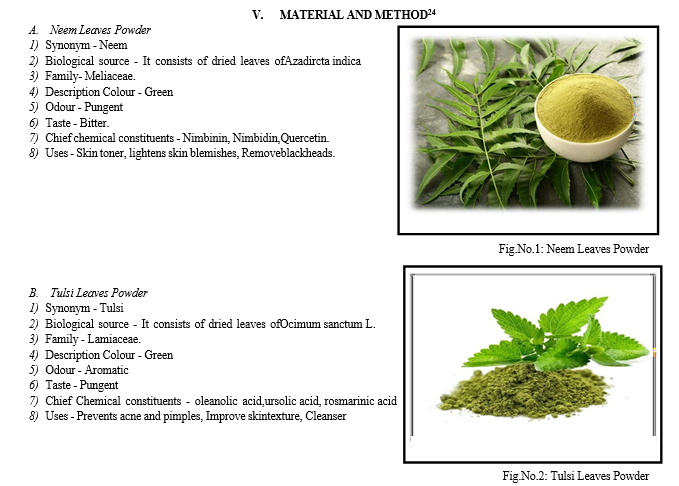
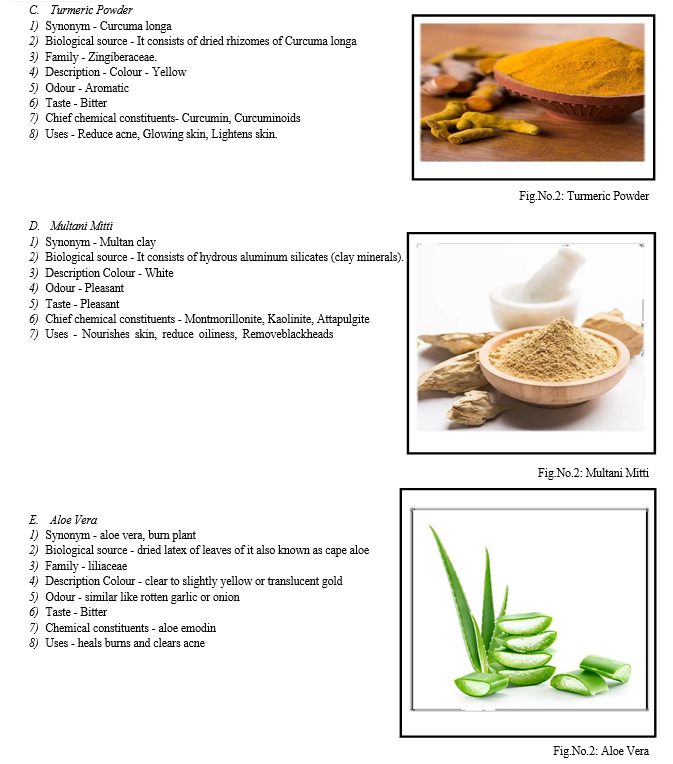
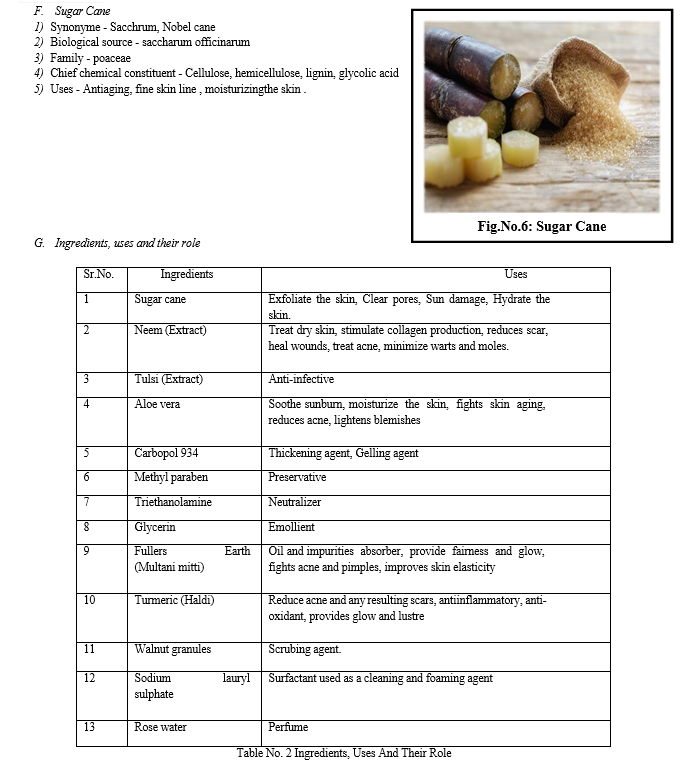
- Materials and Instruments
The brief description of the glass ware, instruments, reagents and chemicals which were used in the study are given below.
2. Glass Ware
Conical flask, Funnel, Glass rod, Pipettes, Measuring cylinder, Reagent bottle, Test tube, Beaker, Slide, Brush, Dropper, Crucible, Capillary tube, Iodine flask.
3. Instrument
Water bath, Electronic weighing machine, Rotatory flask shaker, Hot air oven, Soxhlet extraction unit, Desiccator, Test sieves, Mixer Grinder, Spatula, Heating mantle, Needle, Mortal pistle.
4. Reagents
Fehling?s solution A & B, Dragendorff?s reagent, Mayer?s reagent, Alpha nephthol solution, Wagner?s reagent, Anthrone?s reagent, Folin Denis reagent, Million?s reagent, Hager?s reagent, Aqueous basic lead acetate solution, Ammonia solution, Phosphoric acid.
5. Preparation of Sample Extracts
For analysis of phytochemicals, macerated the 2g of sample of extract with 100 ml distilled water separately in a closed iodine flask for 24 hours, shaking frequently during first 6 hours and allowed to stand for 18 hours. Then the solution was filtered by using whatman filter paper No.1.The extracts were used for the analysis of different bioactive constituents.
H. Preliminary Phytochemicals Screening of Saccharum officinarum (linn.) Stem.30
The extracts obtained from successive solvent extraction were then subjected to various qualitative chemical tests to determine the presence of various phytoconstituents like Alkaloids, Carbohydrates, Proteins, Resins, Saponins, Starch, Flavonoids, Steroids, Glycosides, Tannins, Quinones and Phenolic Compounds Was Analysed by Following Methods.
- Test for Alkaloids
- Mayer's test: Added few drops of Mayer?s reagents to 1 ml of the acidic, aqueous extract of the powder.
- Hager’s test: To 1 ml of alcoholic extract of powder and added few drops of Hangers reagent.
- Dragendroff’s Test: Dissolved few mg of alcoholic or aqueous extract of powder in 5 ml of distilled water, added 2 M HCl until an acid reaction occurs, then added 1 ml of Dragendroff?s reagent.
2. Test for Carbohydrate
- Anthrone’s test: To 2 ml of anthrone?s test solution, added 0.5 ml of aqueous extract of powder. Fehling?s Test: To 2 ml of aqueous extract of powder, added 1 ml of mix. of equal parts of Fehling?s solution A and Fehling?s solution B and boiled the content of the test tube for few minutes.
- Molish’s test: To 2 ml of aqueous extract of the powder, added 2- drops of freshly prepared 20% alcoholic solutions of naphthol and Poured 2 ml of conc. Sulfuric acid so as to form a layer below the mixture.
3. Test for Proteins
- Biuret test: To 1 ml of hot aq. extract of sugarcane powder, added 5 – 8 drops of 10% w/v NaOH solution followed by 1 or 2 drops of 3% w/v CuSO4 solutions.
- Ninhydrin test: The Ninhydrin reagent is 0.1% w/v solution of Ninhydrin in n-butanol. A little of this reagent was added to the test extract.
- Millon’s test: Take little residue was taken with 2 ml of water add millon?s reagent and mix with it, then boil for 1 min and cool under tap water. Add 5 drops of 1% sodium nitrite.
4. Test for Resins
Dissolved 1 ml of extract in 1 ml of acetone and poured the solution into 5 ml distill water.
5. Test for Saponins
- Foam test: To 5 ml of aq. extract of Sugarcane powder, added few drops of sodium bicarbonate. Shaked vigorously and left it for few minutes.
6. Test for Starch
Dissolved 0.015g of iodine and 0.075g of KI in 5 ml of distilled water and added 2 -3 drops of an aq. extract of Sugarcane powder.
7. Test for Flavonoids
- Shinoda's test: To 0.5 ml of alcoholic extract of sugarcane powder, added 5-10 drops of concentrate HCl followed by small 0.5g of „Mg? metal. Alkaline Reagent Test: To the test solution added sodium hydroxide solution.
8. Test for Steroids
- Salkowski’s reaction: Added 1 ml of concentrate Sulfuric acid to 2 ml of chloroform extract of the Sugarcane powder carefully, from the side of test tube.
9. Test for Glycosides
- Borntrager’s test: One ml of benzene and 0.5 ml of dilute ammonia solution were added to the ethanolic extract of sugarcane powder.
10. Test for Tannins
- Ferric chloride test: To 1 – 2 ml of extract of Sugarcane powder, added few drops of 5% FeCl3 solutions.
11. Test for Quinones
1 ml of the sample extract was treated with alcoholic potassium hydroxide solution.
12. Test for Phenolic Compounds
The extract was taken in water and warmed; to this added 2 ml of ferric chloride solution and observed.
I. Composition of Developed Formulation
|
Sr.No. |
Ingredients |
Quantity Taken For 30g Gel |
||
|
F1 |
F2 |
F3 |
||
|
1 |
Sugarcane(glycolic acid) |
2.4ml |
2ml |
2.2ml |
|
2 |
Neem |
0.8ml |
1ml |
1ml |
|
3 |
Tulsi |
0.5ml |
0.5ml |
0.4ml |
|
4 |
Aloe vera |
2.4ml |
2ml |
2ml |
|
5 |
Turmeric |
0.1ml |
0.1ml |
0.3ml |
|
6 |
Carbopol934 |
0.5gm |
0.6gm |
0.6gm |
|
7 |
Methyl paraben |
0.4gm |
0.6gm |
0.6gm |
|
8 |
Triethylamine |
0.4ml |
0.4ml |
0.3ml |
|
9 |
Glycerine |
1.5ml |
2ml |
2ml |
|
10 |
Fullers earth |
2.1gm |
2gm |
2.2gm |
|
11 |
Exfoliating Walnut granules |
8gm |
8gm |
8gm |
|
12 |
Sodium lauryl sulphate |
0.8gm |
0.8gm |
0.8gm |
|
13 |
Rose water |
Q.S |
Q.S |
Q.S |
Table No. 3 Composition Of Developed Formulation
1) Method of Preparation
a) Collection
Leaves of neem, sugarcane, rhizomes of turmeric, aloe vera, leaves of tulsi, were collected from the local area.
b) Preparation of Extract
Leaves of neem, rhizomes of turmeric, leaves of tulsi, were kept in hot air oven for the purpose at 45°C temperature and grinded into small pieces to make powder with the help of grinder.
c) Preparation of Neem and Tulsi Extract
- Desired quantities of herbal drugs were weighed and each herb macerated with ethanol in conical flask.
- Dried herbs were mix with ethanol by moderate shaking of conical flask for 3 days separately.
- After 3 days, contents were filtered out by using simple filtration method and filtrates were collected in vessels separately31.


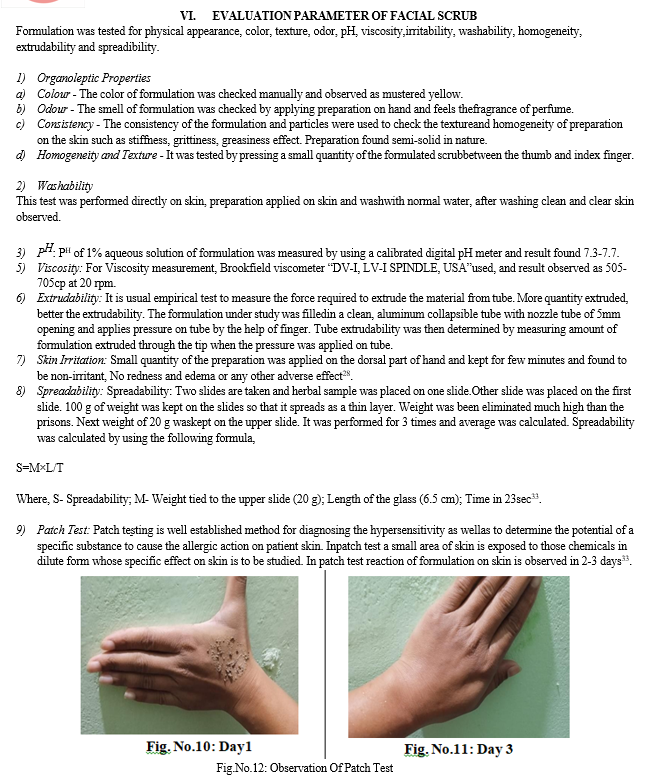


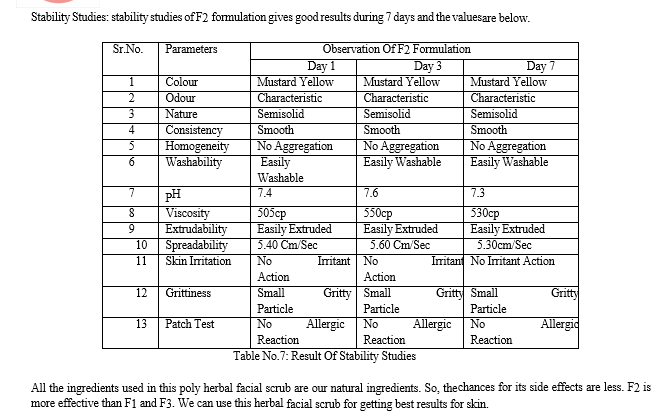
Conclusion
In the current study herbal face scrub was formulated, evaluated for various parameters. The results indicated that the formulation passed the tests. The prepared poly-herbal formulation nourish, moisturize, cleanses, protect the skin against premature aging, acne, and pimples. From the above results it is concluded that new formulation polyherbal scrub can be safe to use and the sugarcane juice in which some amount of glycolic acid is present which used as a scrubbing/cleansing agent showing good effects and as mostly ingredients are natural ingredients so chances for side effects are less. It can be used for any type of skin i.e. normal, oily and dry. It gives best results and make the skin glowing and healthy. . It produces better results and leaves the skin looking radiant and bright. A less amount of the mixture was applied to the dorsal area of the hand for some times and found to be non-irritating, with no redness or other adverse effects.
References
[1] Pandey Shivanand, Meshya Nilam, D.Viral, Herbs Play an Important Role in the Field of Cosmetics, International Journal of PharmTech Research, .2(1); 632-639:2010 [2] V P Kapoor, Herbal cosmetics for skin and hair care, Indian Journal of Natural Products and Resources (IJNPR) [Formerly Natural Product Radiance (NPR)], 4(4):306- 314:2005. [3] Draelos ZD, Botanical antioxidants, Cosmetic Dermatol, 16(10); 41-42:2003 [4] Glaser DA, Anti-ageing products and cosmeceuticals. Facial Plast Surg, Clin N Am, 12(4), 363- 372, 2004. [5] Draelos ZD, Topical Antiinflammatory agents, Cosmetic Dermatol, 16(10); 41-42, 2003. [6] Rousseaux CG and Schachter H, Regulatory issues concerning the safety, efficacy and quality of herbal remedies. Birth Defects Res. B, Dev Reprod Toxicol, 68 (6); 505-510. 2003. [7] Prashant L Kole, Hemant R Jadhav, Prasad Thakurdesai and Anantha Naik Nagappa, cosmetics potential of herbal extracts, Indian Journal of Natural Products and Resources (IJNPR) [Formerly Natural Product Radiance (NPR)], 4(4); 315-321, 2005. [8] Cosmetics [online], Available from: http://en.wikipedia.org/ wiki/Cosmetics [9] Harry RG, In: Modern Cosmeticology [omline], Volume 1,Chemical Pub. Co., 1962, [10] Drugs act Commercial?s, “Manual on Drugs and Cosmetics” [online], Second Edition, Published by Commercial Law Publishers (India) Pvt. Ltd., 2004 [11] European Commission. Official Journal of the European Commission, [online] 1993 [12] Ko, “Adulterants in Asian Patent Medicines”, [online]. J Med, 1998 [13] Larsson, S.C.; Bergkvist, L.; Näslund, I.; Rutegård, J.; Wolk, A. Vitamin A, retinol, and carotenoids and the risk of gastric cancer: a prospective cohort study. Am. J. Clin. Nutr., 85(2); 497–503, 2007. [14] Sweet almond [online], Available from: http://www.cosmetics info. org/ ingredient_details.php?ingredient_id=403 [15] Almond [online], Available from: http://en.wikipedia.org/ wiki/Almond [16] Sathe SK, Wolf WJ, Roux KH, Teuber SS, Venkatachalam M, SzeTao KW. Biochemical characterization of amandin, the storage protein in almond. J Agric Food Chem. 50(2); 4333- 4341, 2002 [17] Almond oil [online], Available from: http://www.dermaxime. com/almondoil.htm [18] Plants Database.United States Department of Agriculture [online].Natural Resources Conservation Service. Available at:http://plants.usda.gov/java/namesearch.Accessed, 2006 [19] Mortensen, A.; Skibsted, L.H. Relative stability of carotenoid radical cations and homologue tocopheroxyl radicals: A real time kinetic study of antioxidant hierarchy. 417(2); 261–266, 1997 [20] Frison S, Sporns P. Variation in the flavonol glycoside composition of almond seedcoats as determined by maldi-tof mass spectrometry. J Agric Food Chem. 50:6818-6822, 2002. [21] Wijeratne SS, Abou-Zaid MM, Shahidi F. Antioxidant polyphenols in almond and its coproducts. J Agric Food Chem. 54(3); 312-318, 2006. [22] “Formulation and evaluation of herbal scrub using tamarind peel” Ghadage P. K.*1 , Mahamuni S. S.1 , Kachare D. S.2 [23] https://en.wikipedia.org/wiki/Exfoliation(cosmetology) [24] Kokate C.K., Purohit A.P., Gokhale S.B., “Pharmacognosy” Nirali Prakashan, 52nd edition. Page no. 19.1-19.2, 14.21, 14.91, and 14.132 [25] vidhya keshav kakd, nisigandha nandkishor dhoke rutuja sanjay sanap sahina rafique sayyed. A review on herbal face scrub, skin exfoliators page no 4. [26] Rutuja Prashant nangare, trupti Ashok thange. Formulation and evalution of polyherbal facial scrub page no.1, International Journal of Research Publication and Reviews. [27] Kumar Sumit, Swarankar Vivek, Sharma Sujata, Baldi Ashish. Herbal Cosmetics: Used for Skin and Hair, page no.1. [28] Mahajan Shraddha, Gayakwad Devshree, Tiwari Abhilasha, Darwhekar G. N. Formulation and Evaluation of Herbo-Mineral Facial Scrub, Journal of Drug Delivery and Therapeutics. [29] FAZNURFARIZA BINTI FIRDAUS @ NICHOLAS (JANUARY 2012) Faculty of Chemical & Natural Resources Engineering UNIVERSITI MALAYSIA PAHANG EXTRACTION OF GLYCOLIC ACID FROM NATURAL SOURCES. [30] Dr.vandana Pathak, Vipin kumar Tiwari phytochemical screening of saccharum officinarum (Linn.) stem. International journal of innovative and research technology31. [31] Dhanashri Sanjay Koli, Abhyangshree Nandkumar Mane, Vinayak Balu Kumbhar, Kalyani Sanjay Shaha “FORMULATION & EVALUATION OF HERBAL ANTI-ACNE FACE WASH” WORLD JOURNAL OF PHARMACY AND PHARMACEUTICAL SCIENCES Volume 5, Issue 6, 2001-2007 [32] ”TEXTBOOK OF MICROBIOLOGY “by M.J. Pelezar,J.R.E.S chain , Noc/ R.K. Poing, fifth edition. [33] J. Prathyusha, N. S. Yamani, G. Santhosh, A. Aravind, B. Naresh Formulation and Evaluation of Polyherbal Face Scrubber for Oily Skin in Gel Form International Journal of Pharmaceutical Sciences and Drug Research 2019; 11(4): 126-128.
Copyright
Copyright © 2023 Anjali Shinde, Bhagyashri Gayke, Madhuri Khandgaonkar. This is an open access article distributed under the Creative Commons Attribution License, which permits unrestricted use, distribution, and reproduction in any medium, provided the original work is properly cited.

Download Paper
Paper Id : IJRASET54833
Publish Date : 2023-07-18
ISSN : 2321-9653
Publisher Name : IJRASET
DOI Link : Click Here
 Submit Paper Online
Submit Paper Online

